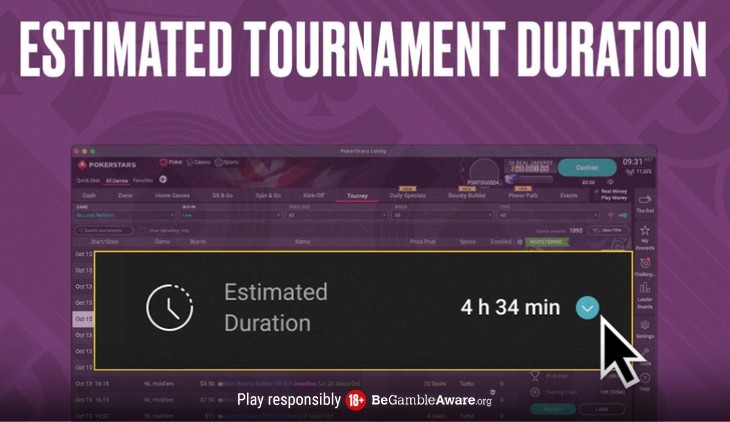

PokerStars is set to roll out a new feature aimed at helping players, particularly recreational ones, better plan their tournament sessions.
Dubbed Estimated Tournament Duration, the tool predicts how long a tournament is likely to run, giving players a clearer idea of the time commitment involved.
Though not yet available, the feature will launch first on PokerStars Ontario, with a rollout to other jurisdictions, including its global PokerStars.com platform as well as PokerStars US, expected in the coming weeks.
- Deposit $10 or more and get a 100% bonus match up to $600
- One of the best mobile apps
- Biggest MTT guarantees
- Excellent tournament schedule
- The best variety of game types
- #1 Rated online poker room in Ontario by pokerfuse.com
- Play one hand & get $150 in bonus play funds
- Top-quality mobile app
- Best online MTT schedule
“We’ve introduced a new prediction tool that estimates how long a poker tournament will last,” the operator stated on their website. “Using a specialised machine learning model, it will help you plan your playing sessions more effectively.”
Multi-table tournaments like the Sunday Million, Sunday Storm, or even daily tournaments can run for several hours, but the total duration from start to finish can vary significantly depending on the tournament.
The key factors influencing how long a tournament lasts are its structure and the number of entrants. For casual players, especially those playing in the evening, it can be hard to commit without knowing whether the tournament will stretch late into the night, potentially cutting into sleep or affecting work the next day.
This new feature aims to solve that problem, helping players make more informed decisions about whether they have the time to see a tournament through, particularly during late-night sessions.
But PokerStars is not the first to introduce a tournament duration prediction tool; operators like Unibet Poker, GGPoker, WPT Global, and the newly launched BetRivers Poker in the US have already implemented similar features.
While the concept remains the same, estimating how long a tournament will last, the execution varies across platforms. Unibet, for instance, which launched this tool in 2020, only reveals the estimated duration once late registration has closed.
GGPoker offers a more advanced version, displaying not only the overall tournament length but also estimated times to reach the money, the final table, and even the expected final table duration. BetRivers’ version, which went live in February, provides estimates for both the total runtime and the time it takes to reach the money.
WPT Global takes a simpler approach, showing only the estimated duration in the tournament lobby. PokerStars’ version will follow a similar format, limited to showing the total estimated duration in the lobby. However, the feature won’t be available for Zoom, phased, multi-day, timed, or freeroll tournaments.
With more operators adopting this feature, it is likely others will follow suit due to growing demand. As of now, 888poker, PartyPoker, iPoker, WSOP Online, and BetMGM Poker in the US have yet to implement such a tool.
Other Recent Changes at PokerStars
As part of its latest software update, PokerStars has also removed the video chat functionality from its Home Games. Originally introduced in December 2021 in the UK following a post-pandemic spike in Home Games activity, the webcam feature later expanded to the global dot-com and other markets in 2022.
The tool allowed players to use their device’s front-facing camera and integrated voice chat to interact in real time during private games. However, it remained exclusive to Home Games and did not extend to other formats.
In addition, PokerStars recently revamped its Spin & Go offering by combining the standard and Flash versions into a single, streamlined variant that combines elements of both. At lower multipliers, games now run faster, adopting the former Flash format with 300 starting chips and blinds increasing every one or two minutes based on the multiplier.
At higher multipliers, the structure retains the standard format with 500 starting chips, but blinds move up more quickly, every three minutes instead of four at the 10x and 25x levels. Games with multipliers of 50x and above continue to follow the original blind schedule.



